Evaluation of Surface Fluxes in the WRF Model: Case Study for Farmland in Rolling Terrain
Abstract
:1. Introduction
2. Materials and Methods
2.1. Observations
2.2. Model Configurations
2.3. Evaluation Methods
3. Results
3.1. Surface Meteorological Variables
3.1.1. Surface Temperature
3.1.2. Surface Water Vapor Mixing Ratio
3.1.3. 10-m Wind Speed
3.2. Turbulence Data
3.2.1. Temporal Variation of Surface Fluxes
3.2.2. Spatial Variation of Surface Fluxes
3.3. Vertical Structure
4. Discussion
4.1. LSMs Sensitivities to Large-Scale Forcing Datasets
4.2. Simulation Differences for Surface Energy Balance
5. Conclusions
Acknowledgments
Author Contributions
Conflicts of Interest
References
- Pleim, J.; Ran, L. Surface flux modeling for air quality applications. Atmosphere 2011, 2, 271–302. [Google Scholar] [CrossRef]
- Zeng, X.-M.; Wang, N.; Wang, Y.; Zheng, Y.; Zhou, Z.; Wang, G.; Chen, C.; Liu, H. WRF-simulated sensitivity to land surface schemes in short and medium ranges for a high-temperature event in east China: A comparative study. J. Adv. Model. Earth Syst. 2015, 7, 1305–1325. [Google Scholar] [CrossRef]
- Gibbs, J.A.; Fedorovich, E.; van Eijk, A.M.J. Evaluating weather research and forecasting (WRF) model predictions of turbulent flow parameters in a dry convective boundary layer. J. Appl Meteorol. Clim. 2011, 50, 2429–2444. [Google Scholar] [CrossRef]
- Cheng, W.Y.Y.; Steenburgh, W.J. Evaluation of surface sensible weather forecasts by the WRF and the Eta models over the western United States. Weather Forecast. 2005, 20, 812–821. [Google Scholar] [CrossRef]
- Panda, J.; Sharan, M. Influence of land-surface and turbulent parameterization schemes on regional-scale boundary layer characteristics over northern India. Atmos. Res. 2012, 112, 89–111. [Google Scholar] [CrossRef]
- Prabha, T.V.; Hoogenboom, G.; Smirnova, T.G. Role of land surface parameterizations on modeling cold-pooling events and low-level jets. Atmos. Res. 2011, 99, 147–161. [Google Scholar] [CrossRef]
- Green, M.C.; Chow, J.C.; Watson, J.G.; Dick, K.; Inouye, D. Effects of snow cover and atmospheric stability on winter PM2.5 concentrations in western US Valleys. J. Appl. Meteorol. Clim. 2015, 54, 1191–1201. [Google Scholar] [CrossRef]
- Lu, W.; Zhong, S. A numerical study of a persistent cold air pool episode in the Salt Lake Valley, Utah. J. Geophys. Res. Atmos. 2014, 119, 1733–1752. [Google Scholar] [CrossRef]
- Peng, J.; Niesel, J.; Loew, A.; Zhang, S.; Wang, J. Evaluation of satellite and reanalysis soil moisture products over southwest China using ground-based measurements. Remote Sens. 2015, 7, 15729–15747. [Google Scholar] [CrossRef]
- Cheng, F.-Y.; Hsu, Y.-C.; Lin, P.-L.; Lin, T.-H. Investigation of the effects of different land use and land cover patterns on mesoscale meteorological simulations in the Taiwan area. J. Appl. Meteorol. Clim. 2013, 52, 570–587. [Google Scholar] [CrossRef]
- LeMone, M.A.; Chen, F.; Alfieri, J.G.; Tewari, M.; Geerts, B.; Miao, Q.; Grossman, R.L.; Coulter, R.L. Influence of land cover and soil moisture on the horizontal distribution of sensible and latent heat fluxes in southeast Kansas during IHOP_2002 and CASES-97. J. Hydrometeorol. 2007, 8, 68–87. [Google Scholar] [CrossRef]
- Ek, M.B.; Mitchell, K.E.; Lin, Y.; Rogers, E.; Grunmann, P.; Koren, V.; Gayno, G.; Tarpley, J.D. Implementation of Noah land surface model advances in the national centers for environmental prediction operational mesoscale Eta model. J. Geophys. Res. Atmos. 2003, 108. [Google Scholar] [CrossRef]
- Xiu, A.; Pleim, J.E. Development of a land surface model. Part I: Application in a mesoscale meteorological model. J. Appl. Meteorol. 2001, 40, 192–209. [Google Scholar] [CrossRef]
- Chen, F.; Zhang, Y. On the coupling strength between the land surface and the atmosphere: From viewpoint of surface exchange coefficients. Geophys. Res. Lett. 2009, 36. [Google Scholar] [CrossRef]
- Hong, S.-Y.; Pan, H.-L. Nonlocal boundary layer vertical diffusion in a medium-range forecast model. Mon. Weather Rev. 1996, 124, 2322–2339. [Google Scholar] [CrossRef]
- Janjic, Z. The surface layer parameterization in the NCEP Eta model. In Proceedings of the 11th Conference on Numerical Weather Prediction, Norfolk, VA, USA, 19–23 August 1996; pp. 354–355. [Google Scholar]
- Gilliam, R.C.; Pleim, J.E. Performance assessment of new land surface and planetary boundary layer physics in the WRF-ARW. J. Appl. Meteorol. Clim. 2010, 49, 760–774. [Google Scholar] [CrossRef]
- Pleim, J.E.; Xiu, A. Development of a land surface model. Part II: Data assimilation. J. Appl. Meteorol. 2003, 42, 1811–1822. [Google Scholar] [CrossRef]
- Pleim, J.E.; Gilliam, R. An indirect data assimilation scheme for deep soil temperature in the Pleim–Xiu land surface model. J. Appl. Meteorol. Clim. 2009, 48, 1362–1376. [Google Scholar] [CrossRef]
- Miao, J.; Chen, D.; Borne, K. Evaluation and comparison of Noah and Pleim–Xiu land surface models in MM5 using GÖTE2001 data: Spatial and temporal variations in near-surface air temperature. J. Appl. Meteorol. Clim. 2007, 46, 1587–1605. [Google Scholar] [CrossRef]
- Peña, A.; Hahmann, A.N. Atmospheric stability and turbulence fluxes at Horns Rev—An intercomparison of sonic, bulk and WRF model data. Wind Energy 2012, 15, 717–731. [Google Scholar] [CrossRef]
- Banks, R.F.; Tiana-Alsina, J.; Baldasano, J.M.; Rocadenbosch, F.; Papayannis, A.; Solomos, S.; Tzanis, C.G. Sensitivity of boundary-layer variables to PBL schemes in the WRF model based on surface meteorological observations, lidar, and radiosondes during the Hygra-CD campaign. Atmos. Res. 2016, 176–177, 185–201. [Google Scholar] [CrossRef]
- Berg, L.K.; Zhong, S. Sensitivity of MM5-simulated boundary layer characteristics to turbulence parameterizations. J. Appl. Meteorol. 2005, 44, 1467–1483. [Google Scholar] [CrossRef]
- Cohen, A.E.; Cavallo, S.M.; Coniglio, M.C.; Brooks, H.E. A review of planetary boundary layer parameterization schemes and their sensitivity in simulating southeastern US cold season severe weather environments. Weather Forecast. 2015, 30, 591–612. [Google Scholar] [CrossRef]
- Shin, H.H.; Hong, S.-Y. Intercomparison of planetary boundary-layer parametrizations in the WRF model for a single day from CASES-99. Bound.-Layer Meteorol. 2011, 139, 261–281. [Google Scholar] [CrossRef]
- Hu, X.-M.; Klein, P.M.; Xue, M. Evaluation of the updated YSU planetary boundary layer scheme within WRF for wind resource and air quality assessments. J. Geophys. Res. Atmos. 2013, 118, 10490–10505. [Google Scholar] [CrossRef]
- Zhang, D.-L.; Zheng, W.-Z. Diurnal cycles of surface winds and temperatures as simulated by five boundary layer parameterizations. J. Appl. Meteorol. 2004, 43, 157–169. [Google Scholar] [CrossRef]
- Patil, M.N.; Waghmare, R.T.; Halder, S.; Dharmaraj, T. Performance of Noah land surface model over the tropical semi-arid conditions in western India. Atmos. Res. 2011, 99, 85–96. [Google Scholar] [CrossRef]
- The Eddy Covariance Method. Available online: https://link.springer.com/chapter/10.1007/978-94-007-2351-1_1#citeas (accessed on 14 November 2011).
- Osibanjo, O.O. Investigation of the Influence of Temperature Inversions and Turbulence on Land-Atmosphere Interactions for Rolling Terrain. Master’s Thesis, University of Nevada, Reno, NV, USA, 2016. [Google Scholar]
- TDL U.S. and Canada Surface Hourly Observations. Available online: https://rda.ucar.edu/datasets/ds472.0/ (accessed on 11 July 2017).
- Shin, H.H.; Hong, S.-Y.; Dudhia, J. Impacts of the lowest model level height on the performance of planetary boundary layer parameterizations. Mon. Weather Rev. 2011, 140, 664–682. [Google Scholar] [CrossRef]
- Smirnova, T.G.; Brown, J.M.; Benjamin, S.G.; Kenyon, J.S. Modifications to the rapid update cycle land surface model (RUC LSM) available in the weather research and forecasting (WRF) model. Mon. Weather Rev. 2016, 144, 1851–1865. [Google Scholar] [CrossRef]
- NCAR. Objective Analysis (Obsgrid). Available online: http://www2.mmm.ucar.edu/wrf/users/docs/user_guide_V3/users_guide_chap7.htm (accessed on 11 June 2017).
- Chen, F.; Kusaka, H.; Bornstein, R.; Ching, J.; Grimmond, C.S.B.; Grossman-Clarke, S.; Loridan, T.; Manning, K.W.; Martilli, A.; Miao, S.; et al. The integrated WRF/urban modelling system: Development, evaluation, and applications to urban environmental problems. Int. J. Climatol. 2011, 31, 273–288. [Google Scholar] [CrossRef]
- Kala, J.; Andrys, J.; Lyons, T.J.; Foster, I.J.; Evans, B.J. Sensitivity of WRF to driving data and physics options on a seasonal time-scale for the southwest of western Australia. Clim. Dyn. 2014, 44, 633–659. [Google Scholar] [CrossRef]
- Morrison, H.; Curry, J.; Khvorostyanov, V. A new double-moment microphysics parameterization for application in cloud and climate models. Part I: Description. J. Atmos. Sci. 2005, 62, 1665–1677. [Google Scholar] [CrossRef]
- Mlawer, E.J.; Taubman, S.J.; Brown, P.D.; Iacono, M.J.; Clough, S.A. Radiative transfer for inhomogeneous atmospheres: RRTM, a validated correlated-k model for the longwave. J. Geophys. Res. Atmos. 1997, 102, 16663–16682. [Google Scholar] [CrossRef]
- Dudhia, J. Numerical study of convection observed during the winter monsoon experiment using a mesoscale two-dimensional model. J. Atmos. Sci. 1989, 46, 3077–3107. [Google Scholar] [CrossRef]
- Kain, J.S. The kain–fritsch convective parameterization: An update. J. Appl. Meteorol. 2004, 43, 170–181. [Google Scholar] [CrossRef]
- Pleim, J.E. A simple, efficient solution of flux–profile relationships in the atmospheric surface layer. J. Appl. Meteorol. Clim. 2006, 45, 341–347. [Google Scholar] [CrossRef]
- Jiménez, P.A.; Dudhia, J. Improving the representation of resolved and unresolved topographic effects on surface wind in the WRF model. J. Appl. Meteorol. Clim. 2012, 51, 300–316. [Google Scholar] [CrossRef]
- Janjić, Z.I. Nonsingular Implementation of the Mellor–Yamada Level 2.5 Scheme in the NCEP Meso Model. Available online: http://www.emc.ncep.noaa.gov/officenotes/newernotes/on437.pdf (accessed on 5 October 2017).
- Jiménez, P.A.; Dudhia, J.; González-Rouco, J.F.; Navarro, J.; Montávez, J.P.; García-Bustamante, E. A revised scheme for the WRF surface layer formulation. Mon. Weather Rev. 2012, 140, 898–918. [Google Scholar] [CrossRef]
- Stull, R.B. An introduction to Boundary Layer Meteorology; Springer Science & Business Media: Dordrecht, The Netherlands, 2012. [Google Scholar]
- Enhanced Meteorological Modeling and Performance Evaluation for Two Texas Ozone Episodes, Project Report Prepared for the Texas Natural Resource Conservation Commissions. Available online: https://www.tceq.texas.gov/assets/public/implementation/air/am/contracts/reports/mm/EnhancedMetModelingAndPerformanceEvaluation.pdf (accessed on 31 August 2001).
- Willmott, C.J. Some comments on the evaluation of model performance. Bull. Am. Meteorol. Soc. 1982, 63, 1309–1313. [Google Scholar] [CrossRef]
- Xie, B.; Fung, J.C.H.; Chan, A.; Lau, A. Evaluation of nonlocal and local planetary boundary layer schemes in the WRF model. J. Geophys. Res. Atmos. 2012, 117. [Google Scholar] [CrossRef]
- Otte, T.L. The impact of nudging in the meteorological model for retrospective air quality simulations. Part I: Evaluation against national observation networks. J. Appl. Meteorol. Clim. 2008, 47, 1853–1867. [Google Scholar] [CrossRef]
- Hariprasad, K.B.R.R.; Srinivas, C.V.; Singh, A.B.; Vijaya Bhaskara Rao, S.; Baskaran, R.; Venkatraman, B. Numerical simulation and intercomparison of boundary layer structure with different PBL schemes in WRF using experimental observations at a tropical site. Atmos. Res. 2014, 145–146, 27–44. [Google Scholar] [CrossRef]
- Zhang, Y.; Gao, Z.; Li, D.; Li, Y.; Zhang, N.; Zhao, X.; Chen, J. On the computation of planetary boundary-layer height using the bulk Richardson number method. Geosci. Model Dev. 2014, 7, 2599–2611. [Google Scholar] [CrossRef]
- Hariprasad, K.B.R.R.; Venkata Srinivas, C.; Venkateswara Naidu, C.; Baskaran, R.; Venkatraman, B. Assessment of surface layer parameterizations in ARW using micro-meteorological observations from a tropical station. Meteorol. Appl. 2016, 23, 191–208. [Google Scholar] [CrossRef]
- Tanaka, H.; Hiyama, T.; Kobayashi, N.; Yabuki, H.; Ishii, Y.; Desyatkin, R.V.; Maximov, T.C.; Ohta, T. Energy balance and its closure over a young larch forest in eastern Siberia. Agr. Forest Meteorol. 2008, 148, 1954–1967. [Google Scholar] [CrossRef]

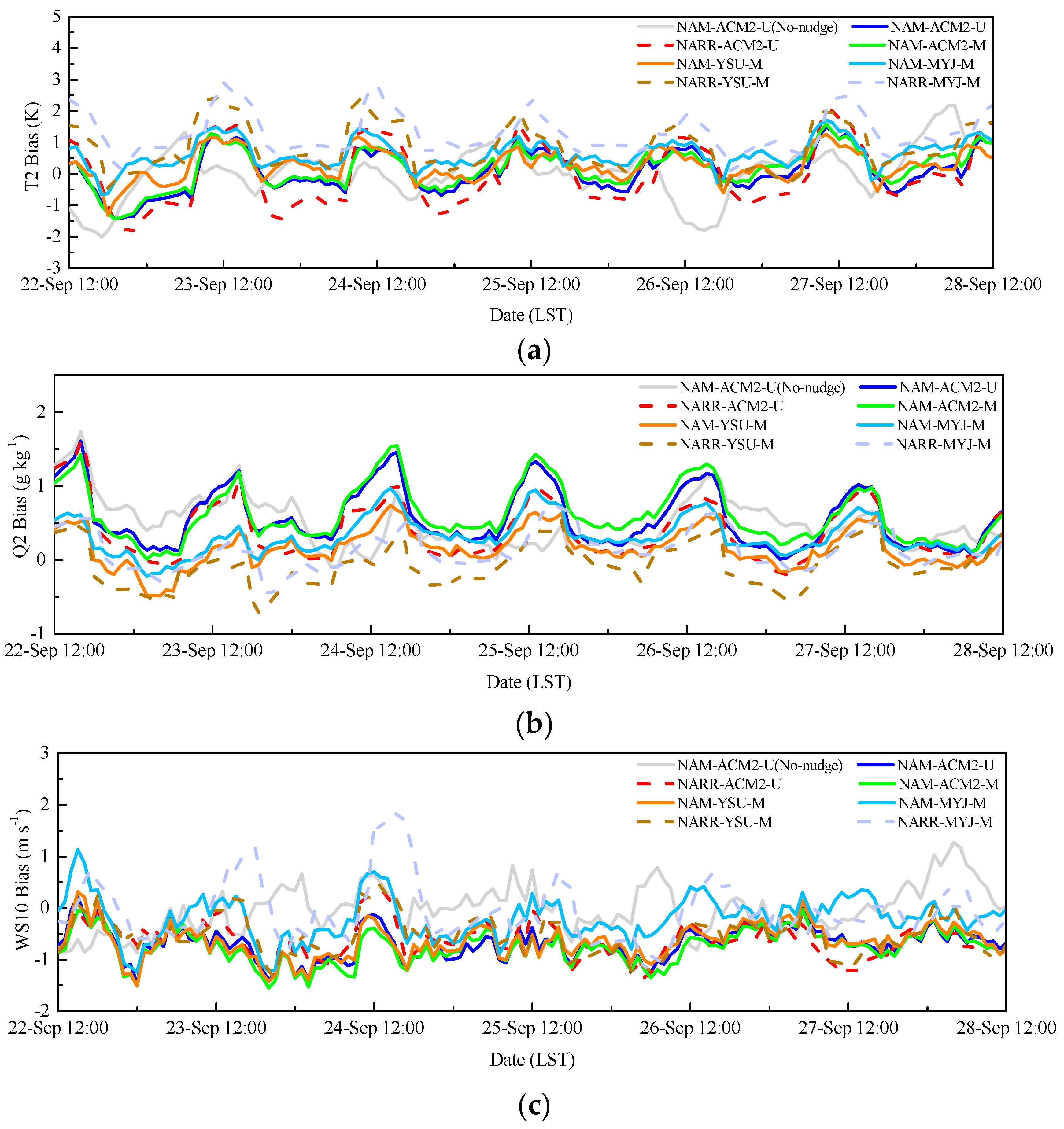
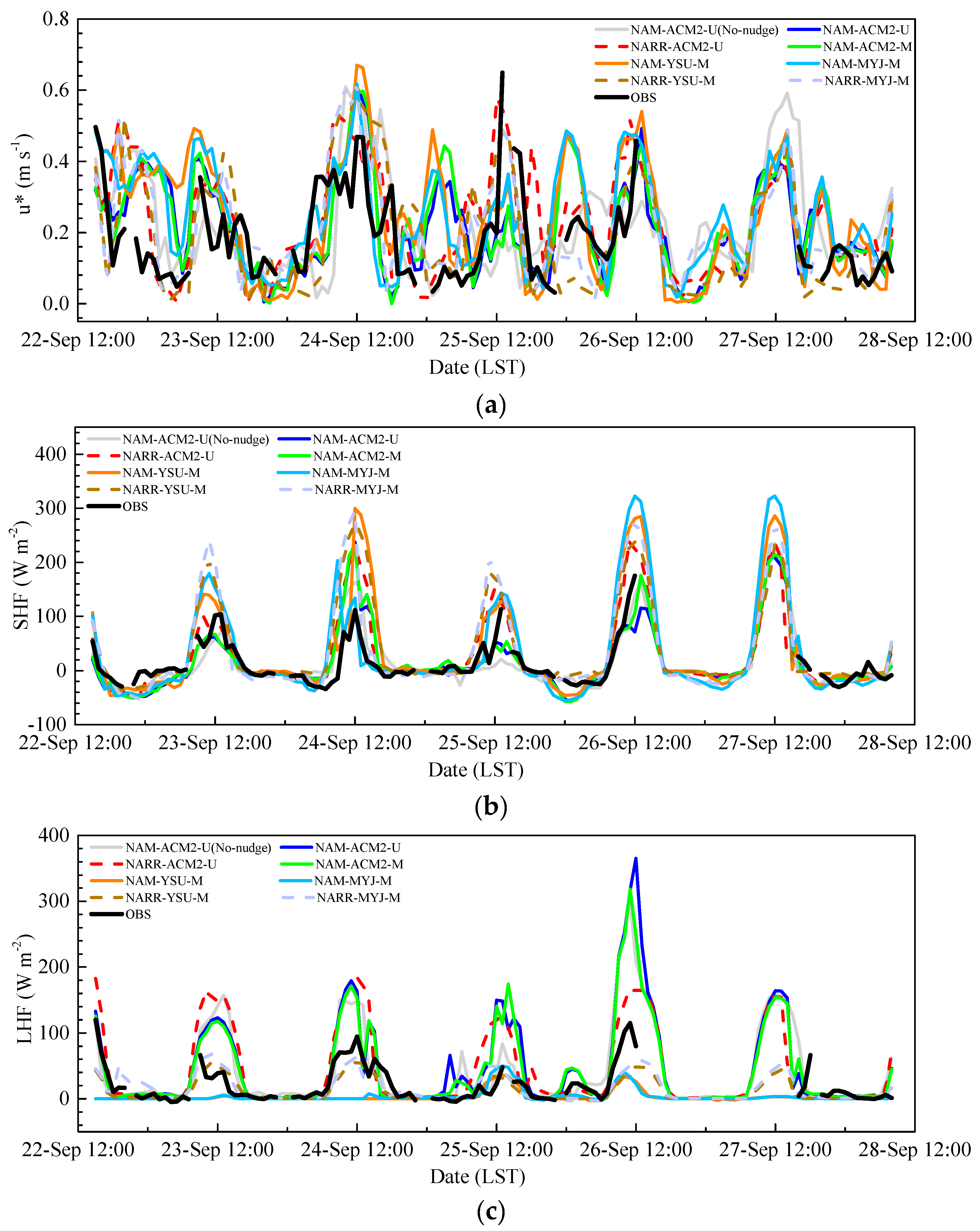
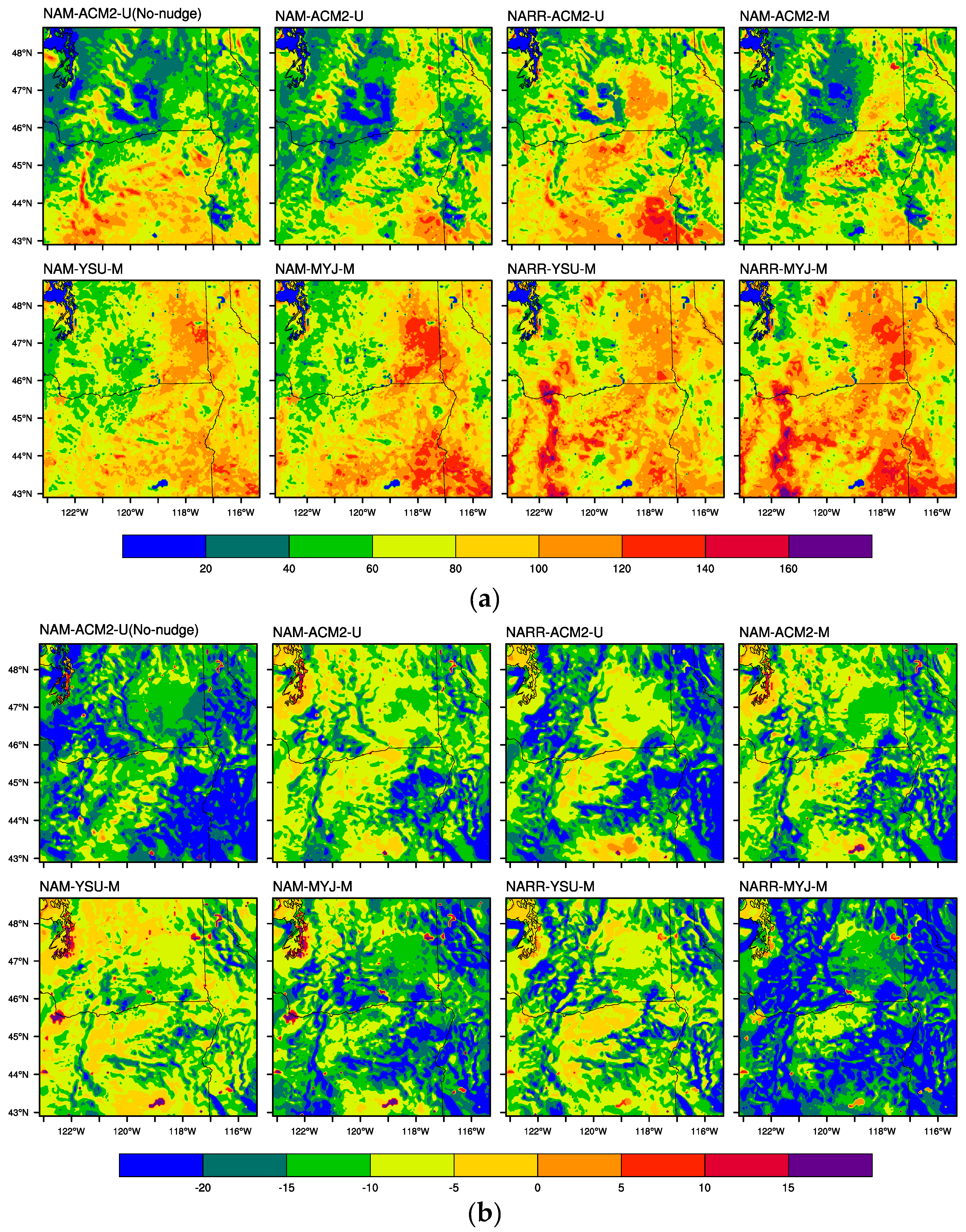
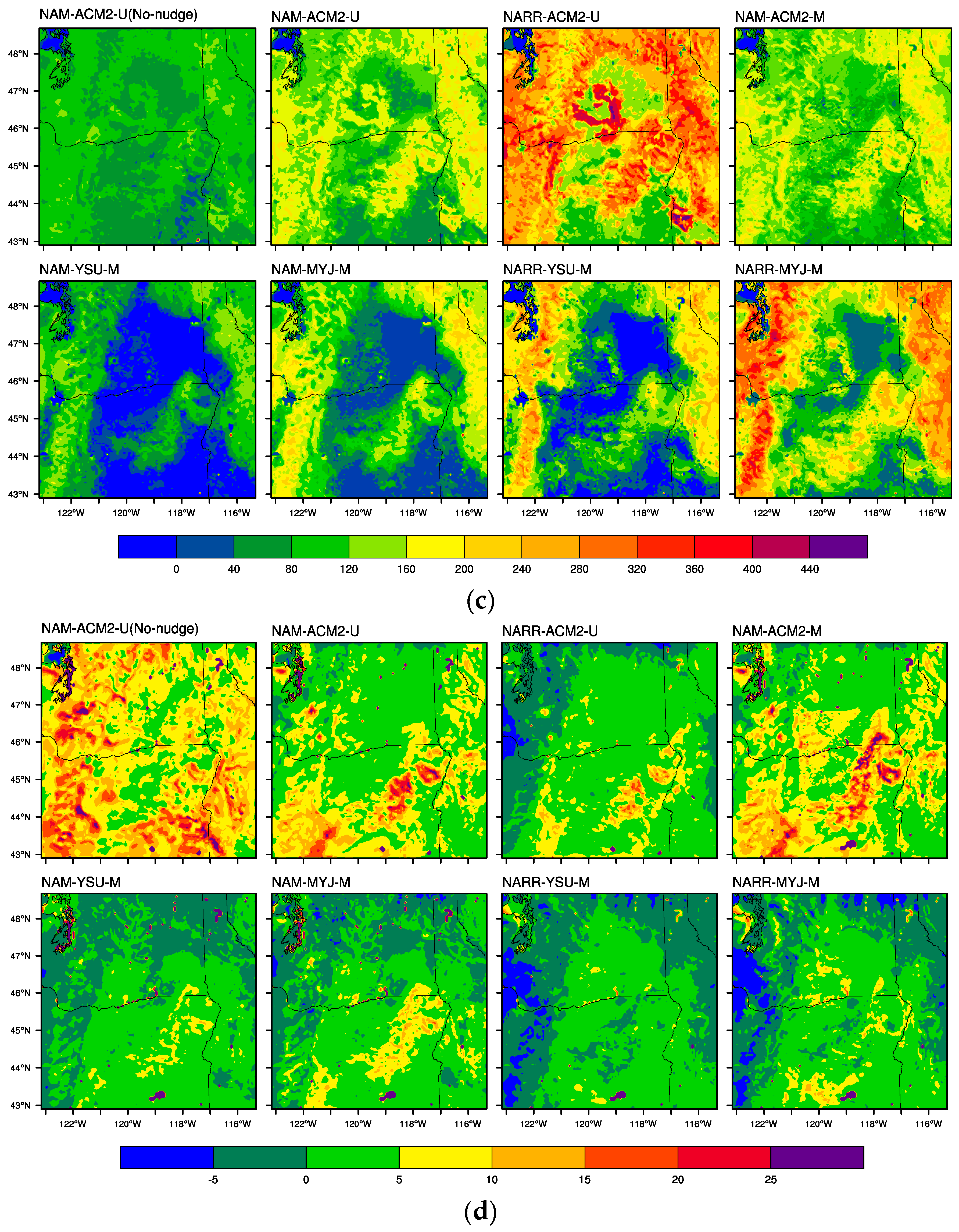

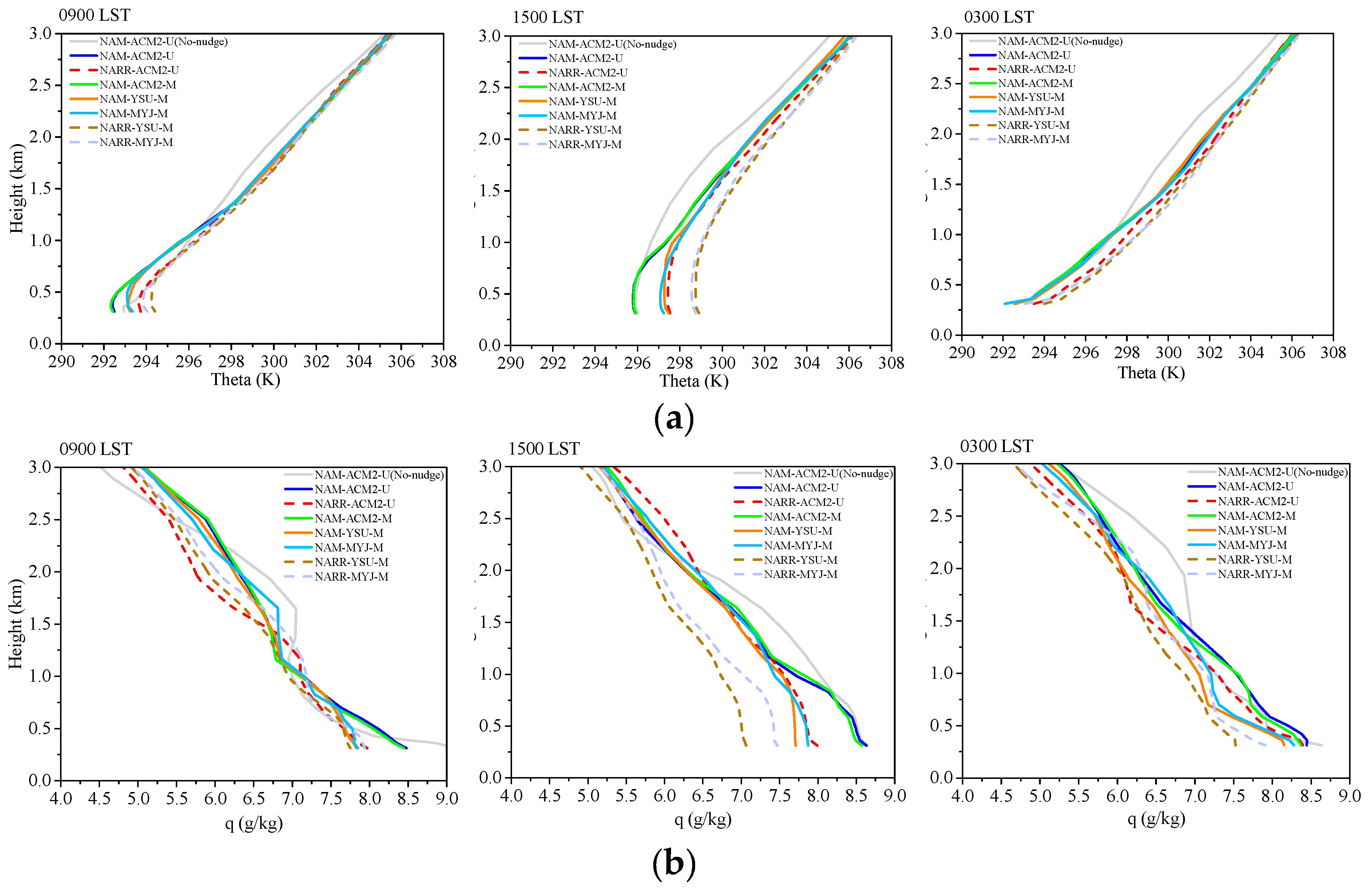
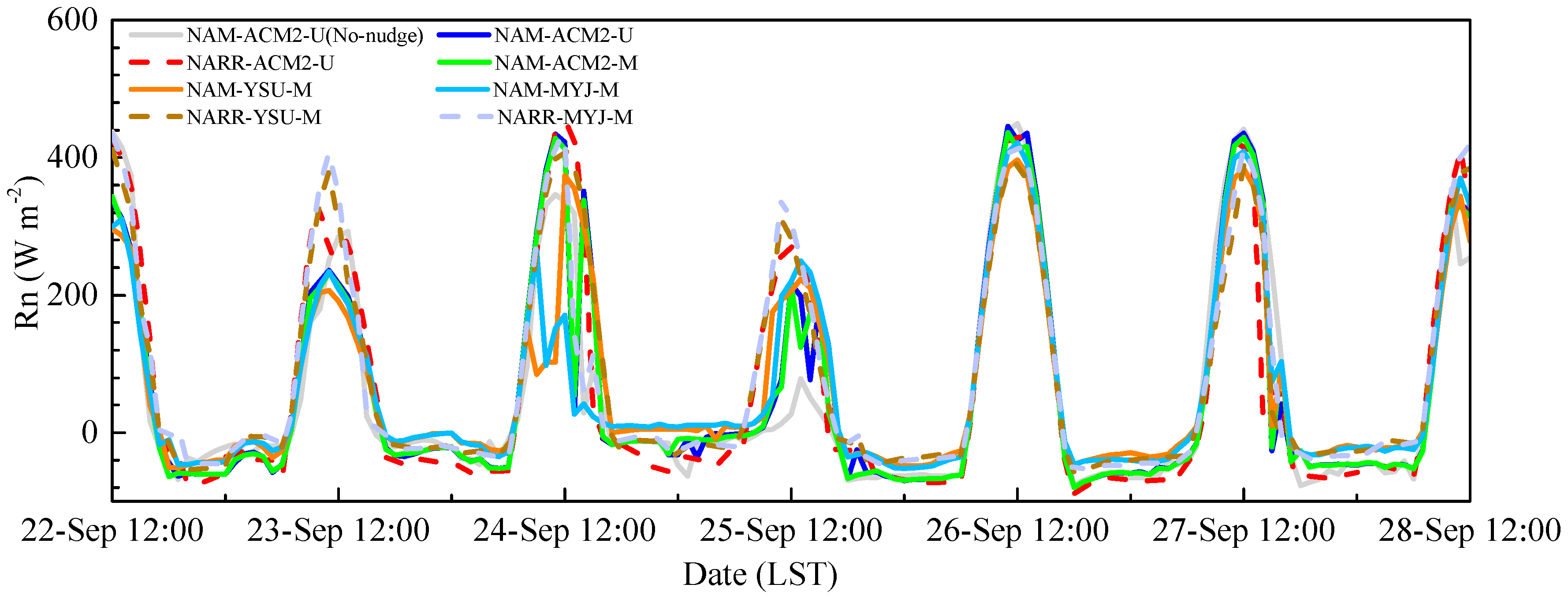
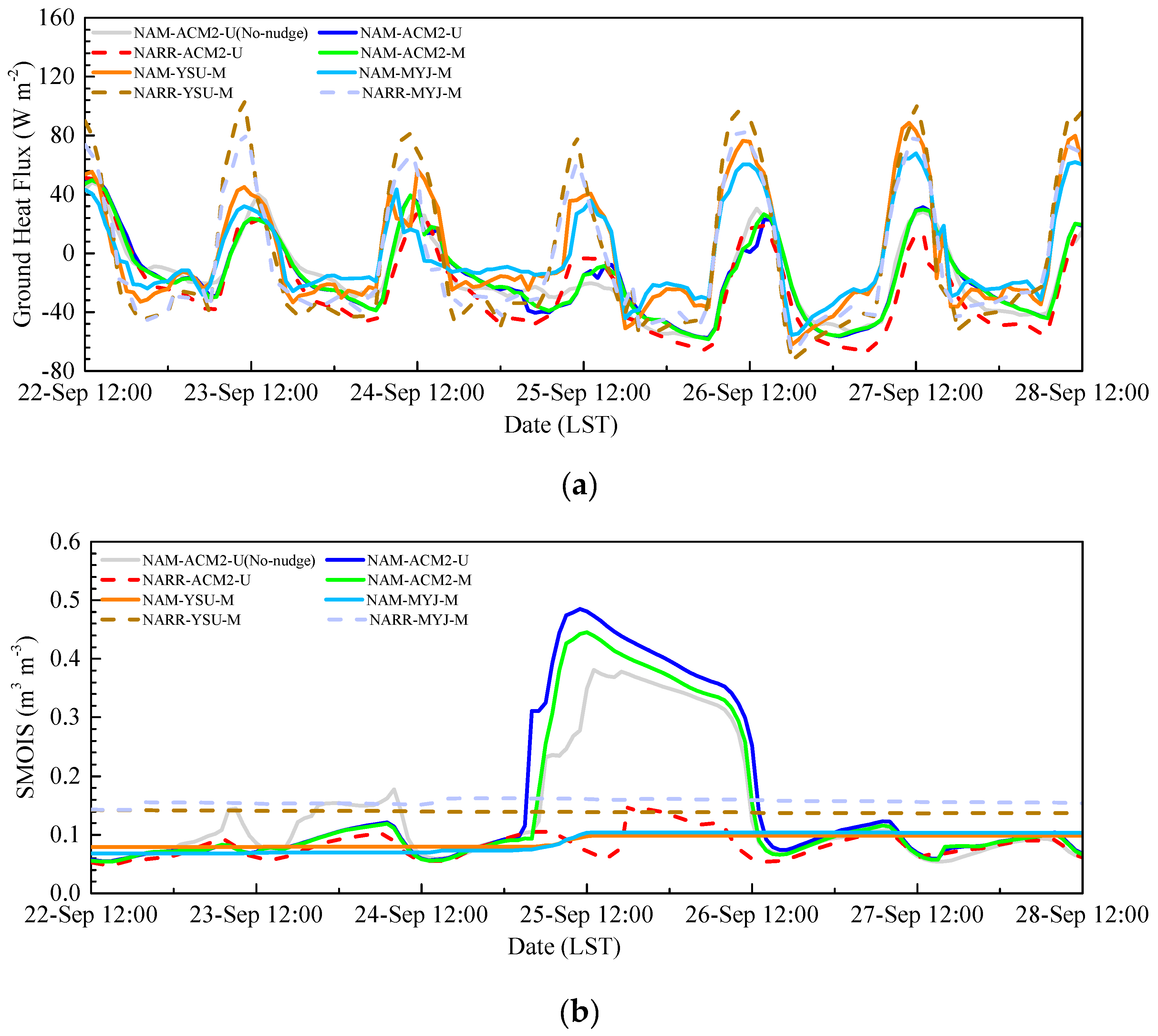
| Experiment | Input Forcing Data (Resolution, Interval) | Land Surface Model | Planetary Boundary Layer Scheme | Surface Layer Scheme | Land Surface INPUT Data |
|---|---|---|---|---|---|
| NAM-ACM2-U (No-nudge) | NAM (12km, 6 h) 1 | Pleim-Xiu | ACM2 2 | Pleim-Xiu Surface layer | USGS 3 |
| NAM-ACM2-U | NAM (12km, 6 h) | Pleim-Xiu | ACM2 | Pleim-Xiu Surface layer | USGS |
| NARR-ACM2-U | NARR (32km, 3 h) 4 | Pleim-Xiu | ACM2 | Pleim-Xiu Surface layer | USGS |
| NAM-ACM2-M | NAM (12 km, 6 h) | Pleim-Xiu | ACM2 | Pleim-Xiu Surface layer | MODIS 5 |
| NAM-YSU-M | NAM (12 km, 6 h) | Noah | YSU 6 | Revised MM5 Similarity | MODIS |
| NAM-MYJ-M | NAM (12 km, 6 h) | Noah | MYJ 7 | Eta similarity | MODIS |
| NARR-YSU-M | NARR (32 km, 3 h) | Noah | YSU | Revised MM5 Similarity | MODIS |
| NARR-MYJ-M | NARR (32 km, 3 h) | Noah | MYJ | Eta similarity | MODIS |
| NAM- ACM2-U (No-nudge) | NAM- ACM2-U | NARR- ACM2-U | NAM- ACM2-M | NAM- YSU-M | NAM- MYJ-M | NARR- YSU-M | NARR- MYJ-M | |
|---|---|---|---|---|---|---|---|---|
| 2-m Temperature (K) | ||||||||
| MB | 0.08 (±0.59) | 0.06 (±0.35) | 0.01 (±0.33) | 0.15 (±0.38) | 0.27 (±0.18) | 0.64 (±0.16) | 0.85 (±0.21) | 1.31 (±0.18) |
| RMSE | 2.13 (±0.40) | 1.69 (±0.20) | 1.87 (±0.19) | 1.80 (±0.22) | 1.81 (±0.20) | 1.80 (±0.17) | 2.18 (±0.17) | 2.28 (±0.19) |
| IOA | 0.91 (±0.02) | 0.95 (±0.01) | 0.95 (±0.01) | 0.95 (±0.01) | 0.95 (±0.01) | 0.95 (±0.01) | 0.93 (±0.01) | 0.92 (±0.01) |
| 2-m Humidity (g kg−1) | ||||||||
| MB | 0.54 (±0.30) | 0.56 (±0.11) | 0.40 (±0.11) | 0.61 (±0.15) | 0.16 (±0.11) | 0.32 (±0.12) | −0.05 (±0.14) | 0.15 (±0.12) |
| RMSE | 1.30 (±0.25) | 0.99 (±0.12) | 0.91 (±0.14) | 1.08 (±0.13) | 0.83 (±0.14) | 0.86 (±0.11) | 0.93 (±0.14) | 0.89 (±0.09) |
| IOA | 0.75 (±0.12) | 0.87 (±0.04) | 0.88 (±0.04) | 0.84 (±0.04) | 0.90 (±0.04) | 0.90 (±0.03) | 0.87 (±0.04) | 0.88 (±0.33) |
| 10-m Wind Speed (m s−1) | ||||||||
| MB | −0.04 (±0.33) | −0.67 (±0.13) | −0.61 (±0.11) | −0.74 (±0.16) | −0.63 (±0.15) | −0.15 (±0.15) | −0.53 (±0.12) | −0.03 (±0.21) |
| RMSE | 1.80 (±0.19) | 1.56 (±0.16) | 1.61 (±0.14) | 1.64 (±0.18) | 1.59 (±0.16) | 1.60 (±0.16) | 1.75 (±0.19) | 1.87 (±0.26) |
| IOA | 0.66 (±0.07) | 0.72 (±0.06) | 0.69 (±0.06) | 0.69 (±0.07) | 0.71 (±0.06) | 0.74 (±0.06) | 0.62 (±0.08) | 0.64 (±0.09) |
| 10-m Wind Direction (deg) | ||||||||
| MB | 8.27 (±4.87) | 4.54 (±2.83) | 7.01 (±1.85) | 4.45 (±3.17) | 5.28 (±4.00) | 4.39 (±3.82) | 7.19 (±4.27) | 5.36 (±4.24) |
| RMSE | N/A1 | N/A | N/A | N/A | N/A | N/A | N/A | N/A |
| IOA | N/A | N/A | N/A | N/A | N/A | N/A | N/A | N/A |
| Experiment | Friction Velocity (m s−1) | Sensible Heat Flux (W m−2) | Latent Heat Flux (W m−2) | ||||||
|---|---|---|---|---|---|---|---|---|---|
| RMSE1 | MB2 | MAE3 | RMSE | MB | MAE | RMSE | MB | MAE | |
| NAM-ACM2-U (No-nudge) | 0.15 | 0.03 | 0.12 | 27.51 | −3.18 | 19.03 | 46.12 | 18.15 | 26.06 |
| NAM-ACM2-U | 0.15 | 0.04 | 0.12 | 34.22 | −0.95 | 21.04 | 55.73 | 24.44 | 30.47 |
| NARR-ACM2-U | 0.14 | 0.06 | 0.11 | 38.83 | 13.25 | 22.32 | 47.88 | 23.24 | 29.52 |
| NAM-ACM2-M | 0.16 | 0.04 | 0.12 | 34.59 | −0.26 | 21.45 | 48.01 | 21.07 | 27.07 |
| NAM-YSU-M | 0.17 | 0.07 | 0.14 | 54.56 | 18.86 | 30.96 | 30.99 | −16.92 | 18.41 |
| NAM-MYJ-M | 0.16 | 0.07 | 0.12 | 49.72 | 11.45 | 29.90 | 30.54 | −15.84 | 18.08 |
| NARR-YSU-M | 0.14 | 0.02 | 0.11 | 59.25 | 27.68 | 33.61 | 20.63 | −8.53 | 13.09 |
| NARR-MYJ-M | 0.13 | 0.03 | 0.10 | 60.17 | 21.61 | 33.90 | 20.60 | −4.37 | 13.40 |
© 2017 by the authors. Licensee MDPI, Basel, Switzerland. This article is an open access article distributed under the terms and conditions of the Creative Commons Attribution (CC BY) license (http://creativecommons.org/licenses/by/4.0/).
Share and Cite
Sun, X.; Holmes, H.A.; Osibanjo, O.O.; Sun, Y.; Ivey, C.E. Evaluation of Surface Fluxes in the WRF Model: Case Study for Farmland in Rolling Terrain. Atmosphere 2017, 8, 197. https://doi.org/10.3390/atmos8100197
Sun X, Holmes HA, Osibanjo OO, Sun Y, Ivey CE. Evaluation of Surface Fluxes in the WRF Model: Case Study for Farmland in Rolling Terrain. Atmosphere. 2017; 8(10):197. https://doi.org/10.3390/atmos8100197
Chicago/Turabian StyleSun, Xia, Heather A. Holmes, Olabosipo O. Osibanjo, Yun Sun, and Cesunica E. Ivey. 2017. "Evaluation of Surface Fluxes in the WRF Model: Case Study for Farmland in Rolling Terrain" Atmosphere 8, no. 10: 197. https://doi.org/10.3390/atmos8100197




